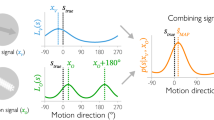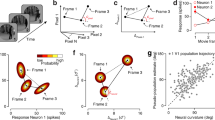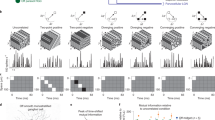Abstract
Physiological models of visual motion processing posit that 'pattern-motion cells' represent the direction of moving objects independent of their particular spatial pattern. We performed fMRI experiments to identify neuronal activity in the human brain selective for pattern motion. A protocol using adaptation to moving 'plaid' stimuli allowed us to separate pattern-motion responses from other types of motion-related activity within the same brain structures, and revealed strong pattern-motion selectivity in human visual area MT+. Reducing the perceptual coherence of the plaids yielded a corresponding decrease in pattern-motion responsivity, providing evidence that percepts of coherent motion are closely linked to the activity of pattern-motion cells in human MT+.
This is a preview of subscription content, access via your institution
Access options
Subscribe to this journal
Receive 12 print issues and online access
$209.00 per year
only $17.42 per issue
Buy this article
- Purchase on Springer Link
- Instant access to full article PDF
Prices may be subject to local taxes which are calculated during checkout


Similar content being viewed by others
References
Movshon, J. A., Adelson, E. H., Gizzi, M. S. & Newsome, W. T. The analysis of moving visual patterns. Exp. Brain Res. 11, 117–152 (1986).
Rodman, H. R. & Albright, T. D. Single-unit analysis of pattern-motion selective properties in the middle temporal visual area (MT). Exp. Brain Res. 75, 53–64 (1989).
Albright, T. D. Direction and orientation selectivity of neurons in visual area MT of the macaque. J. Neurophysiol. 52, 1106–1130 (1984).
Li, B., Chen, Y., Li, B. W., Wang, L. H. & Diao, Y. C. Pattern and component motion selectivity in cortical area PMLS of the cat. Eur. J. Neurosci. 14, 690–700 (2001).
Stoner, G. R. & Albright, T. D. Neural correlates of perceptual motion coherence. Nature 358, 412–414 (1992).
Adelson, E. H. & Movshon, J. A. Phenomenal coherence of moving visual patterns. Nature 300, 523–525 (1982).
Stoner, G. R., Albright, T. D. & Ramachandran, V. S. Transparency and coherence in human motion perception. Nature 344, 153–155 (1990).
Welch, L. The perception of moving plaids reveals two motion-processing stages. Nature 337, 734–736 (1989).
Welch, L. & Bowne, S. F. Coherence determines speed discrimination. Perception 19, 425–435 (1990).
Kooi, F. L. et al. Properties of the recombination of one-dimensional motion signals into a pattern motion signal. Percept. Psychophys. 52, 415–424 (1992).
Smith, A. T. Coherence of plaids comprising components of disparate spatial frequencies. Vision Res. 32, 393–397 (1992).
Heeger, D. J., Boynton, G. M., Demb, J. B., Seidemann, E. & Newsome, W. T. Motion opponency in visual cortex. J. Neurosci. 19, 7162–7174 (1999).
Gegenfurtner, K. R., Kiper, D. C. & Levitt, J. B. Functional properties of neurons in macaque area V3. J. Neurophysiol. 77, 1906–1923 (1997).
Engel, S. A. & Furmanski, C. S. Selective adaptation to color contrast in human primary visual cortex. J. Neurosci. 21, 3949–3954 (2001).
Grill-Spector, K. et al. Differential processing of objects under various viewing conditions in the human lateral occipital complex. Neuron 24, 187–203 (1999).
Huk, A. C., Ress, D. & Heeger, D. J. Neuronal basis of the motion aftereffect reconsidered. Neuron 32, 161–172 (2001).
Kourtzi, Z. & Kanwisher, N. Representation of perceived object shape by the human lateral occipital complex. Science 293, 1506–1509 (2001).
Chawla, D. et al. Speed-dependent responses in V5: a replication study. Neuroimage 9, 508–515 (1999).
Chawla, D., Phillips, J., Buechel, C., Edwards, R. & Friston, K. J. Speed-dependent motion-sensitive responses in V5: an fMRI study. Neuroimage 7, 86–96 (1998).
Huk, A. C. & Heeger, D. J. Task-related modulation of visual cortex. J. Neurophysiol. 83, 3525–3536 (2000).
Glover, G. H. & Lai, S. Self-navigated spiral fMRI: interleaved versus single-shot. Magn. Reson. Med. 39, 361–368 (1998).
Nestares, O. & Heeger, D. J. Robust multiresolution alignment of MRI brain volumes. Magn. Reson. Med. 43, 705–715 (2000).
Zeki, S. et al. A direct demonstration of functional specialization in human visual cortex. J. Neurosci. 11, 641–649 (1991).
Tootell, R. B. et al. Functional analysis of human MT and related visual cortical areas using magnetic resonance imaging. J. Neurosci. 15, 3215–3230 (1995).
Watson, J. D. et al. Area V5 of the human brain: evidence from a combined study using positron emission tomography and magnetic resonance imaging. Cereb. Cortex 3, 79–94 (1993).
Engel, S. A., Glover, G. H. & Wandell, B. A. Retinotopic organization in human visual cortex and the spatial precision of functional MRI. Cereb. Cortex 7, 181–192 (1997).
Engel, S. A. et al. fMRI of human visual cortex. Nature 369, 525 (1994).
DeYoe, E. A. et al. Mapping striate and extrastriate visual areas in human cerebral cortex. Proc. Natl. Acad. Sci. USA 93, 2382–2386 (1996).
Sereno, M. I. et al. Borders of multiple visual areas in humans revealed by functional magnetic resonance imaging. Science 268, 889–893 (1995).
Smith, A. M. et al. Investigation of low frequency drift in fMRI signal. Neuroimage 9, 526–533 (1999).
Acknowledgements
We thank W. Newsome for helpful comments. The research was supported by an NEI grant (RO1-EY12741) and a grant from the Human Frontier Science Program (RG0070/1999-B).
Author information
Authors and Affiliations
Corresponding author
Rights and permissions
About this article
Cite this article
Huk, A., Heeger, D. Pattern-motion responses in human visual cortex. Nat Neurosci 5, 72–75 (2002). https://doi.org/10.1038/nn774
Received:
Accepted:
Published:
Issue Date:
DOI: https://doi.org/10.1038/nn774
This article is cited by
-
Tracking perceptual decision mechanisms through changes in interhemispheric functional connectivity in human visual cortex
Scientific Reports (2019)
-
Disentangling locus of perceptual learning in the visual hierarchy of motion processing
Scientific Reports (2019)
-
Inhibition-excitation balance in the parietal cortex modulates volitional control for auditory and visual multistability
Scientific Reports (2018)
-
Coherent versus Component Motion Perception in Autism Spectrum Disorder
Journal of Autism and Developmental Disorders (2008)
-
Global motion integration in the postero-medial part of the lateral suprasylvian cortex in the cat
Experimental Brain Research (2006)



